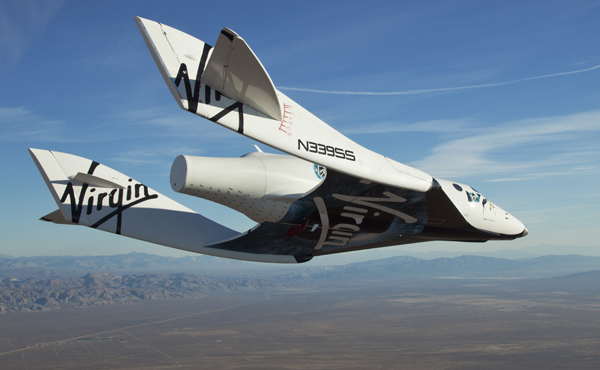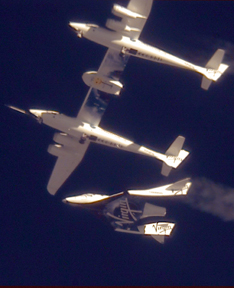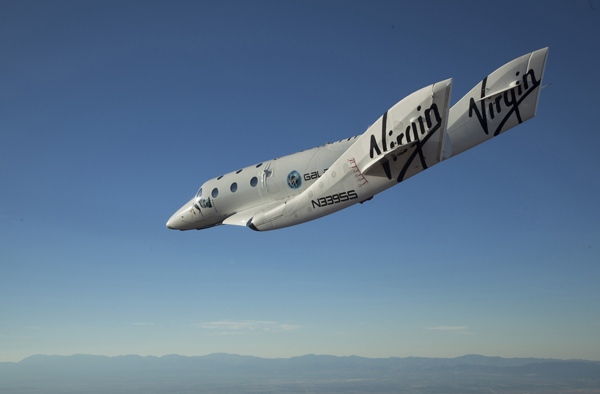SpaceShipTwo makes first gliding free flight (UPDATED)
10/10/2010 06:30 PM Filed in: Commercial Space | Space News
Editor's note...
With Scaled Composites pilot Pete Siebold and co-pilot Mike Alsbury at the controls, the futuristic twin-tail spacecraft glided to a touchdown at the Mojave Air and Space Port eleven minutes after its release from WhiteKnightTwo, also known as Eve. The craft was not equipped with a rocket motor for the glide test.
"It was a very important milestone," Richard Branson, founder of the Virgin Group, told CBS News in a telephone interview. "It was one of the three big milestones still to go. To see it successfully drop and successfully glide back down to Earth and to see it perform so well was significant. An incredibly important day."
Goals of the flight, Virgin Galactic said in a statement, were to characterize the release dynamics and to make an initial evaluation of handling and stall characteristics, to compare stability and control with predictions from computer models, to evaluate lift and drag and to carry out a descent to landing.
"The VSS Enterprise was a real joy to fly, especially when one considers the fact that the vehicle has been designed not only to be a Mach 3.5 spaceship capable of going into space but also one of the worlds highest altitude gliders," Siebold said in a Virgin Galactic press release.
Virgin Galactic is building the rocket-powered SpaceShipTwo to carry six passengers and two pilots into space on sub-orbital up-and-down flights that will provide several minutes of weightlessness and a view of Earth previously enjoyed only by government-sponsored test pilots, astronauts and cosmonauts.
"The next important thing will be the rocket tests with astronauts inside it," Branson said. "In about a week's time, we're going to be unveiling ... the spaceport in New Mexico, and that's a key component of everything. And then, obviously, by the end of next year or the beginning of the following year, we'll be doing our first flights actually into space with people on it."
Designed by Scaled Composites and legendary aircraft builder Burt Rutan, SpaceShipTwo evolved from the smaller SpaceShipOne rocketplane that won the $10 million Ansari X Prize in 2004 for becoming the first commercial manned rocket to reach an altitude of 100 kilometers, or 62 miles. Branson started Virgin Galactic to market flights on a commercial basis.
Tickets initially will cost some $200,000 per seat. Despite the steep price tag, Virgin has collected $50 million in deposits from 370 potential customers. Commercial operations will be based at Spaceport America in New Mexico.
After an extensive flight test program, "I'll be on the first official flight and very much looking forward to it," Branson told CBS News.
George Whitesides, CEO of Virgin Galactic, said in the company statement that with the first drop test successfully concluded "our challenge going forward will be to complete our experimental program, obtain our FAA license and safely bring the system into service at Spaceport America."
"At the end of the day, getting hardware off the ground is what it's really all about," John Gedmark, executive director of the Commercial Spaceflight Federation, said in a statement. "Today's SpaceShipTwo test flight marks another key milestone towards opening the space frontier for private individuals, researchers, and explorers. Congratulations to the entire SpaceShipTwo team."
- Updated at 6:30 PM EDT, 10/10/10, with Branson interview.
With Scaled Composites pilot Pete Siebold and co-pilot Mike Alsbury at the controls, the futuristic twin-tail spacecraft glided to a touchdown at the Mojave Air and Space Port eleven minutes after its release from WhiteKnightTwo, also known as Eve. The craft was not equipped with a rocket motor for the glide test.
"It was a very important milestone," Richard Branson, founder of the Virgin Group, told CBS News in a telephone interview. "It was one of the three big milestones still to go. To see it successfully drop and successfully glide back down to Earth and to see it perform so well was significant. An incredibly important day."
Goals of the flight, Virgin Galactic said in a statement, were to characterize the release dynamics and to make an initial evaluation of handling and stall characteristics, to compare stability and control with predictions from computer models, to evaluate lift and drag and to carry out a descent to landing.
 |
Virgin Galactic's SpaceShipTwo, known as the VSS Enterprise, flies free during its first glide-to-landing test flight. (Photo: Virgin Galactic/Mark Greenberg) |
"The VSS Enterprise was a real joy to fly, especially when one considers the fact that the vehicle has been designed not only to be a Mach 3.5 spaceship capable of going into space but also one of the worlds highest altitude gliders," Siebold said in a Virgin Galactic press release.
 |
The VSS Enterprise drops away from WhiteKnightTwo. (Photo: Virgin Galactic/Clay Observatory) |
Virgin Galactic is building the rocket-powered SpaceShipTwo to carry six passengers and two pilots into space on sub-orbital up-and-down flights that will provide several minutes of weightlessness and a view of Earth previously enjoyed only by government-sponsored test pilots, astronauts and cosmonauts.
"The next important thing will be the rocket tests with astronauts inside it," Branson said. "In about a week's time, we're going to be unveiling ... the spaceport in New Mexico, and that's a key component of everything. And then, obviously, by the end of next year or the beginning of the following year, we'll be doing our first flights actually into space with people on it."
Designed by Scaled Composites and legendary aircraft builder Burt Rutan, SpaceShipTwo evolved from the smaller SpaceShipOne rocketplane that won the $10 million Ansari X Prize in 2004 for becoming the first commercial manned rocket to reach an altitude of 100 kilometers, or 62 miles. Branson started Virgin Galactic to market flights on a commercial basis.
Tickets initially will cost some $200,000 per seat. Despite the steep price tag, Virgin has collected $50 million in deposits from 370 potential customers. Commercial operations will be based at Spaceport America in New Mexico.
After an extensive flight test program, "I'll be on the first official flight and very much looking forward to it," Branson told CBS News.
George Whitesides, CEO of Virgin Galactic, said in the company statement that with the first drop test successfully concluded "our challenge going forward will be to complete our experimental program, obtain our FAA license and safely bring the system into service at Spaceport America."
 |
The VSS Enterprise descending to the Mojave Desert landing site. (Photo: Virgin Galactic/Mark Greenberg) |
"At the end of the day, getting hardware off the ground is what it's really all about," John Gedmark, executive director of the Commercial Spaceflight Federation, said in a statement. "Today's SpaceShipTwo test flight marks another key milestone towards opening the space frontier for private individuals, researchers, and explorers. Congratulations to the entire SpaceShipTwo team."